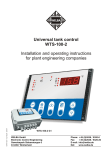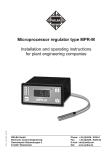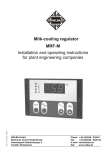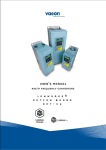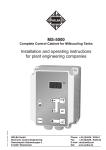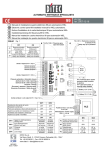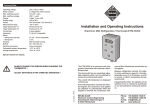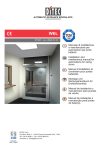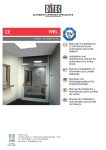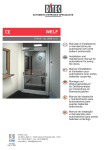Download Installation and operating instructions for plant
Transcript
WELBA Temperature regulator MPR-A 101658 - © by WELBA - 01/04/09 Installation and operating instructions for plant engineering companies WELBA GmbH Electronic Control Engineering Gewerbepark Siebenmorgen 6 D-53547 Breitscheid Phone: Fax: E-mail: Net: +49 (0)2638 / 9320-0 +49 (0)2638 / 9320-20 [email protected] www.welba.de Inhaltsverzeichnis Function . . . . . . . . . . . . . . . . . . . . . . . . . . . . . . . . . . . . . . . . . Page 3 Intended use . . . . . . . . . . . . . . . . . . . . . . . . . . . . . . . . . . . . . Page 3 Safety . . . . . . . . . . . . . . . . . . . . . . . . . . . . . . . . . . . . . . . . . . . Page 3 Key to models. . . . . . . . . . . . . . . . . . . . . . . . . . . . . . . . . . . . . Page 4 Installation . . . . . . . . . . . . . . . . . . . . . . . . . . . . . . . . . . . . . . . Page 5 Dimensions and techn. data regulator . . . . . . . . . . . . . . . . . . Page 7 Dimensions and techn. data sensor (accessory) . . . . . . . . . . Page 7 Operating regulator . . . . . . . . . . . . . . . . . . . . . . . . . . . . . . . . Page 8 Examples of use. . . . . . . . . . . . . . . . . . . . . . . . . . . . . . . . . . . Page 8 Notes for programing of the regulator . . . . . . . . . . . . . . . . . . Page 11 Parameter settings in general . . . . . . . . . . . . . . . . . . . . . . . . Page 12 Working level operation . . . . . . . . . . . . . . . . . . . . . . . . . . . . . Page 12 Programming level operation . . . . . . . . . . . . . . . . . . . . . . . . . Page 13 Configuration level operation . . . . . . . . . . . . . . . . . . . . . . . . . Page 14 Setting the actual value correction . . . . . . . . . . . . . . . . . . . . . Page 16 Fault indication on the display . . . . . . . . . . . . . . . . . . . . . . . . Page 16 General measures when using electronic control systems . . Page 17 Function The microprocessor-controlled temperature regulator of the series MPR-A are used to control heating and cooling processes. Depending on the number of switching stages, the regulator unit has between one and four relay contacts to control the compressor, heaters, alarms, fans, etc. The measured temperature of the medium is permanently displayed. If this temperature deviates from the selected target temperature by the hysteresis value, the appropriate relay contact is activated. The operation and the default values of the regulator are subdivide in three parameter levels. The assessment for each level is configurable by the assemblyman. At the first operating level the working level a button can be pressed to display and change the target temperature set for relay contact K1. (The alter of the target temperature for the operating level can be looked.) MPR-A 28/08/08 Page 2 Intended use These operating instructions contain important technical and safety information. Please read carefully before installation and before any work on or with the regulator. The microprocessor-controlled temperature regulator type MPR-A is used to control heating and cooling systems, alarm devices, fans, etc. Any other use of the device is permitted only with prior written permission from the manufacturer. The microprocessor controller can be used after the parameters has been adjusted if it is used the first time. To get start the controller without the adjustments is not igneous and can destroy the facility or the medium which temperature has to be controlled. The device is fitted with a resistance temperature sensor. The output ports are designed as potential-free relay ports. The device must not be installed in potentially explosive atmospheres. The microprocessor-controlled temperature regulator type MPR-A meets the EC requirements for electromagnetic compatibility (EMC) and complies with the "low voltage" directive (LVD). The safety components meet the VDE regulations. Safety The temperature regulator may only be installed by an authorised specialist, observing all local safety requirements. Only specialists must be allowed to access the environment when connected. The temperature regulator contains live components and must not be opened. The device must not be used if the housing or the connection terminals are damaged. No liquids must penetrate the housing. The temperature regulator may be exported to the USA with the permission of the manufacturer only. MPR-A 28/08/08 Page 3 Key to models The microprocessor controlled temperature regulator MPR-A is available in different versions. The type definition of the device can you find on the top of the housing (see picture). The type definition is configured as follows: M P R A - - - Switching stages Sensor preparation Voltage Switching stages Sensor preparation Voltage 1 2 3 4 KT KTY 81-210 P2 PT100 (2 leads) P3 PT100 (3leads) 1 switch. stage 2 switch. stages 3 switch. stages 4 switch. stages A C D F 230V AC, 50/60 Hz 24V AC, 50/60 Hz 24V DC 24V UC This manual contains all specifications to operate all variants. MPR-A 01/04/09 Page 4 Installation 1 2 3 °C SET a. It is essential not to install the device under the following conditions: ! severe jolting or vibration ! permanent contact with water ! relative humidity of more than 90% ! sharply fluctuating temperatures (condensation) ! aggressive atmospheres (ammonia or sulphur fumes). Risk of oxidation. ! operation in the immediate vicinity of radio transmitters with increased levels of spurious radiation. b. Housing installation The housing is mounted using two lateral screw fittings. ! Fit the rubber seal as shown ! Place the housing throught thr front opening. ! Attach the lateral screw fittings. ! Thighten the screws. c. Installing the sensor The temperature controller has been configured for a specific kind of sensors by the manufacturer (see type key). Notice that the controller can only work well if the right type of the sensor is fitted. The sensor cable must not be chafed or kinked. There must be no substantial mechanical pressure on the sensor tube. Do not place the sensor and the power cable in the same cable conduit. After finishing the electrical connections the regulator must be adjust in the parameter “Sensor correction” [C91] that the measured temperature is equal with the value on the display. Therefore it must used a reference thermometer. See the section "Setting the actual value correction" on page 16. Observe the permitted temperature range to which the sensor is suited: Sensor cable PVC (standard) Silicon Teflon MPR-A 28/08/08 Temperature range -30° to + 70 ° -50° to +150° -100° to +205° Page 5 d. Electrical connection Before connecting, ensure that the mains voltage is the same as indicated on the device's type plate. Incorrect electrical connection can cause damage to the regulator and to the equipment. The mains voltage should not be switched on until all components including the sensor are connected. When connecting appliances (or loading the relay contacts) with currents of >10A AC1, it is essential to fit contactors. Downstream contactors must be fitted with an RC protection circuit. (see also page 17). You will find the correct circuit diagram for your regulator on the back of the housing, above the connection terminals.. * = depending on the number of switching stages KTY10-6 K1 K2* The electrical connection procedure is as follows: ! Connect heating and cooling systems in accordance with the appropriate circuit diagram. ! Connect alarm devices, fans, etc. ! Connect mains supply leads. K3* PT100 A1 A2 1 2 3 4 5 6 7 8 9 10 11 12 13 14 15 Sensor MPR-A Observe the following tips: ! Use cable bushes. ! Make sure that cables cannot chafe. Operating voltage 28/08/08 Page 6 Dimensions and technical data regulator Operating voltage Relay contacts 48 Max. switching current Max. switching voltage Display Display range - range -9,9 .. 99,9°C - other Control type Measurement range Usable sensor types Hysteresis Operation 42 96 77 88 8 90 76 Housing - front-panel cut-out - installation depth Protection (housing front) Connection Ambient temperature - operating temperature - storage temperature - max. humidity See key to models 1 voltage-free two-way-contact each switch setting 10 A AC1 each 250 V ~ each 13 mm LED display, 3 digits 0.1°C 1.0°C Two-step regulator KTY 81-210 or PT 100 0.1 K to 99.9 K freely adjustable Heating/cooling interchangeable each switch setting NEG 48/96 M - 42 x 90 mm - 88 mm IP 64 Screw terminals -20° to +70°C 0° to +50°C 75% (no condensation) Technical facts with reservation. 40 mm 6,0 mm 6,1 mm Dimensions and technical data sensor Bush material Bush length Bush diameter 1.4301(V2A) 40 mm 6.0 mm +/- 0.1 Sensors other than our standard type are available on request (different bush from or cable length). Some of the options are shown here. MPR-A 28/08/08 Page 7 Operating regulator The regulator operates at three levels: °C 1 2 3 4 Working level: .…for everyday operation by the end user. The present temperature of the medium as measured is permanently displayed. SET Press the SET button to see the target temperature set for output port relay K1. Press the up-arrow or down-arrow key as the same time as the SET button to adjust the target temperature. NB: The target temperature can be adjusted here only if the programming level button lock [C99] is set to “0” Working level for every day operation Programming level for setting the regulator parameters Programming level: This is the level at which the regulatory parameters are set. Setting is more complex and possible only using specific combinations of buttons so as to prevent accidental changes to settings. Configuration level: This is the level at which the basic functions of the regulator are set. As subsequent interventions by the end user (after the parameters have been set) can result in dangerous changes to functions which might not be immediately obvious, access to the configuration level is even more complex. Configuration level for setting the basic functions Important: When programming the target temperatures for the various appliances that are connected, take account of which target temperature the end user is most likely to need to adjust. Regardless of the number of switching stages, only the target temperature for output relay K1 can be directly adjusted at working level. Examples of use The MPR-A series of microprocessor controlled regulators are very versatile: Depending on the number of switching stages, they can be used to control up to four appliances (heating, cooling or alarm systems). The following examples show two possible uses and the appropriate parameter settings. MPR-A 28/08/08 Page 8 Example 1: MPR-A with 2 switching stages (three-point regulation) to control a cooling and heating system 1 2 °C SET K1 KTY10-6 1 2 3 4 5 6 7 8 9 10 11 12 13 14 15 K1 Cooling Operating voltage 9° T2 Heater 4° Hysteresis for T1 (upwards only) K2 A1 A2 Sensor T1 Cooling Hysteresis for T2 (downwards only) 0° K2 Heater A medium has to be maintained at a temperature of between 9°C and 4°C. The deviation must not exceed 0.5K. A cooling and a heating system is to be used (three point regulation). Proceed as fallows: Programming level: ! Set parameter for target-temperature 1 [C1] to 9°C ! Set parameter for target-temperature 2 [C2] to 4°C ! Set hysteresis parameter for target-temp. 1 [C20] to 0.5K ! Set hysteresis parameter for target-temp. 2 [C21] to 0.5K Configuration level: ! Set switch direction parameter for relay K1 [P1] to 1 (cooling contact) ! Set switch direction parameter for relay K1 [P2] to 0 (heating contact) ! Set parameters for function K1 and K2 for sensor failure [P10+P11] as desired ! Set hysteresis mode parameter for target 1 [P15] to 1 [mono-direction] ! Set hysteresis mode parameter for target 2 [P16] to 2 [mono-direction] ! Set the remaining parameters as desired Operation ! If the temperature of the medium rises to 9.5°C, cooling is switched on, and then switched off again at 9°C ! If the temperature of the medium falls below 3,5°C, heating is switched on, and then switched off again at 4°C MPR-A 28/08/08 Page 9 Example 2: MPR-A with four switching stages to control of two cooling systems, a heating system and a alarm system 1 2 °C 13° T2 Cooling 1 10° Hysteresis for T2 / 0,8K (upwards only) T1 Heater 6° T4 Alarm Hysteresis for T1 / 0,6K (downwards only) 3° Hysteresis for T4 / 0,1K (downwards only) SET K1 KTY10-6 K2 A1 A2 1 2 3 4 5 6 7 8 9 10 11 12 13 14 15 Operating voltage Sensor K3 Hysteresis for T3 / 0,5K (upwards only) T3 Cooling 2 0° K4 16 1718 19 20 21 22 23 24 25 26 27 28 29 30 K3 Cooling 2 K2 Cooling 1 Caution: The device is programmed so that the target temperature for heating can be changed at working level. This is why the heating system is connected to relay contact K1. K1 Heater K4 Alarm A medium is to be maintained at a temperature of between 13°C and 6°C. The permissible temperature deviations are controlled by the hysteresis settings. The temperature is to be controlled by two cooling systems, which will be switched on one depending on the temperature of the medium. A heating system will prevent the temperature from falling below 6°C. An additional alarm is to be activated at 3°C Proceed as follows: Programming level: ! Set parameter for target temperature 1 [C1] to 6°C ! Set parameter for target temperature 2 [C2] to 10°C ! Set parameter for target temperature 3 [C3] to 13°C ! Set parameter for target temperature 4 [C4] to 3°C ! ! ! ! Set hysteresis parameter for target-temp. 1 [C20] to 0.6K Set hysteresis parameter for target-temp. 2 [C21] to 0.8K Set hysteresis parameter for target-temp. 3 [C22] to 0.5K Set hysteresis parameter for target-temp. 4 [C23] to 0.1K See next page. MPR-A 28/08/08 Page 10 Configuration level ! Set switching direction param. for K1 [P1] to 0 (heating contact) ! Set switching direction param. for K2 [P2] to 1 (cooling contact) ! Set switching direction param. for K3 [P3] to 1 (cooling contact) ! Set switching direction param. for K4 [P4] to 0 (heating contact) ! Set parameters for functions K1 to K4 for sensor failure [P10P13] as desired ! Set hysteresis mode parameter for target 1 [P15] to 1 (monodirectional) ! Set hysteresis mode parameter for target 2 [P16] to 1 (monodirectional) ! Set hysteresis mode parameter for target 3 [P17] to 1 (monodirectional) ! Set hysteresis mode parameter for target 4 [P18] to 1 (monodirectional) Mono directional hysteresis mode means: - switching direction for cooling contact: hysteresis upwards - switching direction for heating contact: hysteresis downwards ! Set the remaining parameters as desired Operation: " If the temperature of the medium rises to 10.8°C, cooling system 1 is switched on, and then switched off again at 10°C. " If the capacity of cooling system 1 is not sufficient, and the temperature continues to rise to 13,5°C, cooling system 2 is switched on, and then switched off again at 13°C. " If the temperature of the medium falls below 5.4°C, the heating system is switched on, and then switched off again at 6°C. " If the capacity of heating system is not sufficient, and the temperature continues to fall below 2,9°C, the alarm is triggered and continues until the temperature rises above 3,0°C. Notes for programing of the regulator Before starting operation, all pre-set parameters should be adjusted to suit local conditions. Wrongly set parameters can have a serious effect on functions. The following pages educible all the steps involved in programming the various models. In following the instructions for the various parameters, take account of now many switching stages your regulator has (see also “key to models” section) For example, a two-stage regulator does not have parameters [C3] + [C4] for the second and third temperatures, etc." Important: We recommend recording details of the settings before delivery to your customer. In this way you will be able to supply spare regulators pre-set. When replacing a regulator, the only adjustment to be made at the end user's premises will then be the actual value correction. MPR-A 28/08/08 Page 11 Parameter settings in general 1 2 3 4 To adjust a parameter, proceed as follows: ! Select parameter (on pressing the SET button, the present value will be displayed). ! Holding the SET button down, simultaneously press the uparrow or down-arrow until the desired value is reached. ! Tip: Holding the arrow down longer changes the value more quickly. ! Release the SET button. °C 15. 8 To store the changed parameter in the memory, first release the arrow, and then the SET button. SET Switch back to working level (possible from every parameter) ! Press up-arrow and down arrow simultaneously for about 5 seconds. The current actual value appears in the display. (If, at programming or configuration level, no buttons are presses for about 1 minute, the regulator switches back to working level automatically.) Working level operation The working level is for everyday operation by the end user. The display permanently shows the present temperature of the medium as measured. 1 2 1 2 3 4 3 SET 15. 8 Button Function °C 4 5 1 Display (the measured temperature of the medium is permanently displayed.) 2 LED - Display "Relay contact K1" LED - Display "Relay contact K2" (when fitted) LED - Display "Relay contact K3" (when fitted) LED - Display "Relay contact K3" (when fitted) These show when the corresponding relay contact is activated. 3 Press SET button: Display the target temperature set for relay contact K1 4* Press up-arrow together with SET button: Increases target temperature for relay contact K1 5* Press down-arrow together with SET button: Reduces target temperature for relay contact K1 * (See also “button lock” parameter at programming level) MPR-A 28/08/08 Page 12 Programing level operation 1 2 3 4 15. 8 The programming level is for setting the regulator parameters. Access to this level is more complex in order to avoid accidental resetting of the values by the end user. Switching to programing level: ! Press up-arrow and down-arrow simultaneously for approx. 5 seconds, until [C1] appears in the display. ! Press up-arrow or down arrow until you reach the parameter you want adjust. °C SET Meaning of parameters Operating diagram programming level Switch to programming level = Press simultaneously for approx. 5 Show setting Change setting Press SET button Press SET button and or simultaneously or Target temperature 1 C1 Target temperature 2 C2 Target temperature 3 C3 Target temperature 4 C4 Hysteresis for target temperature 1 C20 Hysteresis for target temperature 2 C21 Hysteresis for target temperature 3 C22 Hysteresis for target temperature 4 C23 Sensor correction C91 Button lock C99 SET or SET Switch back to working level = Press simultaneously for approx. 5 seconds (Switches back automatically after approx. 1 minute if no further buttons are pressed). Parameter C1: Target temperature for K1 Parameter C2: Target temperature for K2 (when fitted) Parameter C3: Target temperature for K3 (when fitted) Parameter C4: Target temperature for K4 (when fitted) The target temperature is the temperature at which the corresponding relay contact is to be activated. Parameter C20: Hysteresis for target-temp. 1 Parameter C21: Hysteresis for target-temp. 2 (when fitted) Parameter C22: Hysteresis for target-temp. 3 (when fitted) Parameter C23: Hysteresis for target-temp. 4 (when fitted) The hysteresis determines the value by which the temperature of the medium may deviate from the Target temperature Hysteresis for corresponding target temperature “cooling T2 contact” T2 higher before the relay contact is activat- Target temperature “heating ed. See sketch. contact” T1 Hysteresis for T1 lower If the contact in question is for cooling, the hysteresis is always 0° higher. In the case of heating contacts it is below the target temperature. (cooling or heating contact is set at configuration level). In the “symmetrical” hysteresis mode, the value selected is distributed on both sides of the target temperatures. Parameter C91: Actual value correction A correction can be made to the value as measured by the sensor, which applies cumulatively over the entire measuring range. See the section “Setting the actual value correction” on page 16. Parameter C99: Button lock This can be used to prevent adjustment of the target temperature for outlet port relay K1 in the working level . 0 = Buttons not locked 1 = buttons locked MPR-A 28/08/08 Page 13 Configuration level operation 1 2 3 4 15. 8 This level is for configuring the regulator's basic functions. To prevent interference by the end user, access is made even more complex. °C Switching to configuration level: ! Press up-arrow and down-arrow simultaneously for approx. 5 seconds, until [C1] appears in the display. ! Press button "Arrow UP" repeatedly until the last parameter [C99] at working level is reached. ! Press button "Arrow UP" again and hold down until [Pb] appears in the display. ! When [Pb] appears, hold down button "Arrow UP" and simultaneously press button "Arrow DOWN" for approx. 3 seconds. The display then shows the first parameter [P1] in the configuration level. SET Operating diagram configuration level Switching to configuration level: see description Show setting Press SET button Change setting Press SET button and or simultaneously Meaning of parameters or Switching direction K1 P1 Switching direction K2 P2 Switching direction K3 P3 Switching direction K4 P4 Sensor failure function K1 P10 Sensor failure function K2 P11 Sensor failure function K3 P12 Sensor failure function K4 P13 Hysteresis mode for 1 P15 Hysteresis mode for 2 P16 Hysteresis mode for 3 P17 Hysteresis mode for 4 P18 SET Parameter P1: Switching direction relay K1 Parameter P2: Switching direction relay K2 (when fitted) Parameter P3: Switching direction relay K3 (when fitted) Parameter P4: Switching direction relay K4 (when fitted) The switching direction can be set as a heating or cooling contact for each individual relay contact. 0 = Heating contact 1 = Cooling contact Param. P10: Funct. K1 in event of sensor failure Param. P11: Funct. K2 in event of sensor failure (when fit) Param. P12: Funct. K3 in event of sensor failure (when fit) Param. P13: Funct. K4 in event of sensor failure (when fit) The switching status of the relay contacts can be set for the event of a sensor failure. 0 = OFF in the event of failure 1 = ON in the event of failure or SET Param. P15: Hysteresis mode target temp. 1 Param. P16: Hysteresis mode target temp. 2 (when fitted) Param. P17: Hysteresis mode target temp. 3 (when fitted) Param. P18: Hysteresis mode target temp. 4 (when fitted) (with reference to the compressor relay) 0 = symmetrical 1 = one-sided Operating diagram configuration level MPR-A 28/08/08 Page 14 Operating diagram configuration level Show setting Press SET button Change setting Press SET button and or simultaneously or Limit for T1 downwards P20 Limit for T1 upwards SET P21 Limit for T2 downwards P22 Limit for T2 upwards when fitted Parameter P22: Limit for target temp. 2 downwards Parameter P23: Limit for target temp. 2 upwards Parameter P24: Limit for target temp. 3 downwards Parameter P25: Limit for target temp. 3 upwards Parameter P26: Limit for target temp. 4 downwards Parameter P27: Limit for target temp. 4 upwards Setting of input limits for target temperatures at working and programming levels. Range: -50 .. +400°C Parameter P30: Limit for hysteresis 1 downwards Parameter P31: Limit for hysteresis 1 upwards P23 Limit for T3 downwards P24 Limit for T3 upwards Parameter P20: Limit for target temp. 1 downwards Parameter P21: Limit for target temp. 1 upwards when fitted Parameter P32: Limit for hysteresis 2 downwards Parameter P33: Limit for hysteresis 2 upwards Parameter P34: Limit for hysteresis 3 downwards Parameter P35: Limit for hysteresis 3 upwards Parameter P36: Limit for hysteresis 4 downwards Parameter P37: Limit for hysteresis 4 upwards Setting of input limits for hysteresis at programming level. Range: -50 .. +400 K P25 Limit for T4 downwards P26 Limit for T4 upwards P27 Limit for hysteresis 1 downwards P30 Limit for hysteresis 1 upwards P31 Limit for hysteresis 2 downwards P32 Parameter P50: Minimum action time for relay K1 Parameter P51: Minimum pause time for relay K1 Limit for hysteresis 2 upwards P33 Limit for hysteresis 3 downwards P34 Limit for hysteresis 3 upwards P35 Limit for hysteresis 4 downwards P36 Limit for hysteresis 4 upwards P37 Min. action time K1 P50 when fitted Parameter P52: Minimum action time for relay K2 Parameter P53: Minimum pause time for relay K2 Parameter P54: Minimum action time for relay K3 Parameter P55: Minimum pause time for relay K3 Parameter P56: Minimum action time for relay K4 Parameter P57: Minimum pause time for relay K4 Setting of minimum action time or minimum pause time for relay contacts, in order to prevent repeated switching on and off. Range: 0.0 .. 999 seconds Min. pause time K1 P51 Min. action time K2 P52 Min. pause time K2 P53 Min. action time K3 P54 Min. pause time K3 P55 Min. action time K4 P56 Min. pause time K4 P57 Temperature scale P99 Parameter P99: Temperature scale To switch the display between degrees Fahrenheit and degrees Celsius. 0 = Celsius 1 = Fahrenheit or SET Switch back to working level = Press simultaneously for approx. 5 seconds (Switches back automatically after approx. 1 minute if no further buttons are pressed). MPR-A 28/08/08 Page 15 Setting the actual value correction A correction can be made to the value as measured by the sensor, which applies cumulatively over the entire measuring range. This is necessary when: - the length of the sensor cable is changed, or - a faulty sensor is replaced, giving rise to an incorrect reading. In order to adjust the actual value correction, a reference thermometer (e.g. WELBA THM-2000) is needed. Proceed as follows: ! Install sensor. ! Measure the temperature of the medium using the reference thermometer. ! Switch on the thermostat and set parameter [C91] in the programming level to "0". ! Switch back to working level and read the measured temperature on the display. ! Calculate the difference between the reference thermometer temperature and the display reading. ! Store the difference (pay attention to plus or minus) in the working level under parameter [C91]. Fault indication on the display 1 2 3 4 15. 8 °C Faults in the regulator are indicated by a flashing display as follows: LED - Display F1 Sensor short circuit: The sensor or sensor cable is faulty and must be replaced or repaired. Parameter [C91] "Actual value correction" must then be adjusted at programming level. F2 Broken sensor: The sensor or sensor cable is faulty and must be replaced or repaired. Parameter [C91] "Actual value correction" must then be adjusted at programming level. F3 Memory fault: Faulty regulator! Remove the regulator and send it for repair. FFF Measurement range exceeded: The maximum measurement range of the sensor has been exceeded. SET MPR-A 28/08/08 Fault Page 16 General measures when using electronic control systems So that even complicated regulatory tasks can be presented to the user in a manner which is clear and simple and ensures high measurement accuracy, today's electronic control systems make increasing use of microprocessors. However, the benefits of these systems are countered by the disadvantage that increased measurement accuracy is accompanied by sensitivity to interference. In order to minimise the effect which interference may have on the regulator, the user also must take account of a number of points when installing a new regulator. Assistance here is provided by standard DIN VDE 0843 on the electromagnetic compatibility (EMC) of measurement, control and regulatory devices in industrial process technology. The following table shows, for example, the maximum interference levels to which, according to the standard, an appliance may be exposed. Degree of severity Environment class Test voltage Power supply Test voltage Signal/control line 1 well-protected environment 0.5 kV 0.25 kV 2 protected environment 1.0 kV 0.5 kV 3 typical industrial environment 2.0 kV 1.0 kV 4 Industrial environment with very high interference level 4.0 kV 2.0 kV As the values given in the table are maximum values, operational values should remain well below them. However, in practice this is possible only with difficulty, as even a normal contactor without interference suppression produces interference pulses of up to 3.0 kV. For this reason we recommend that the following principles be taken into account during installation: a. Try to eliminate all sources of interference, by carrying out interference suppression and minimising the interference level. Radio interference suppression is required under VDE 0875, and confirmed by VDE 0874. In principle, interference must be eliminated at source. The nearer the interference suppresser is to the source of interference, the greater its effect. Interference spreads through wires or by electromagnetic radiation. It is usually the former which interferes most seriously with regulation systems. Possible interference sources (to name but a few) include: ! bouncing contacts when switching loads ! switching off inductive loads (contactors, motors, solenoid valves, etc.) ! unsatisfactory routing of wires, too small cross-sections ! loose contacts ! rhythmically changing power stages (power converters) ! power breakers ! high-frequency generators MPR-A 28/08/08 Page 17 b. If specific interference sources cannot be avoided, they should at least be kept at a distance from the regulator system. c. Capacitive and inductive couplings can cause crosstalk between highvoltage lines and parallel low-voltage and sensor lines. This distorts measured values and signals and can disrupt the entire regulatory process. It is therefore recommended that all sensors and signal lines be placed separately from the control and mains voltage lines. d. If possible, a separate mains line should be provided to feed the regulator system. This helps reduce any interference penetrating the regulator via the mains supply line. Voltage surges resulting from switching substantial loads will also then be less of a problem. e. In the case of contactors, solenoid valves and other inductive consumers, the induction voltage occurring during switching has to be reduced by appropriate protection methods. The choice of methods depends on whether the consumer runs on DC or AC voltage. U+ Regulator contact Coil Diode U- Regulator contact AC Coil RCFilter ! DC voltage In the case of d/c voltage systems, the induction voltage occurring can, for example, be limited by using self-induction diodes, varistors or suppresser diodes. The diagram on the left shows one possibility using a self-induction diode. ! AC voltage In the case of a/c voltage, interference suppression as described above is not possible. Instead, an RC combination must be used. An RC filter must be connected as directly as possible to the inductance, in order to ensure a short line. In addition, the component ratings of the RC combination must be geared to the inductance. Too low ratings lead to excessive voltage, and too high ratings cause significant losses in the interference suppresser component. Another point to note here is that only capacitors which meet VDE 0656 may be used. They must be suited to the mains voltage and designed for very high switching voltages. The diagram on the left shows inductance interference suppression using an RC filter. An RC filter should not be fitted directly to the regulator's switching contact, as shown on the left, as an idle current will flow through the RC combination even when the switching contact is open. This current may be enough to mean that a downstream contactor is not de-energised and a closed protective contact does not reopen. MPR-A 28/08/08 Page 18 f. Semiconductor switches such as thyristors or triacs also produce interference voltages. They occur as a result of non-linear characteristics and finite ignition voltages. These components must be protected against excessive voltages, for which mainly varistors, RC combinations or choke coils are used. The use of zero-voltage switches is also recommended. The suggestions made represent only a few of the possible ways of protecting a microprocessor-controlled regulator system from interference. The suggested measures have the advantage that they will increase the lifetime of the devices, as lower induction voltages (reduced spark formation) will also reduce contact burn. MPR-A 28/08/08 Page 19



















